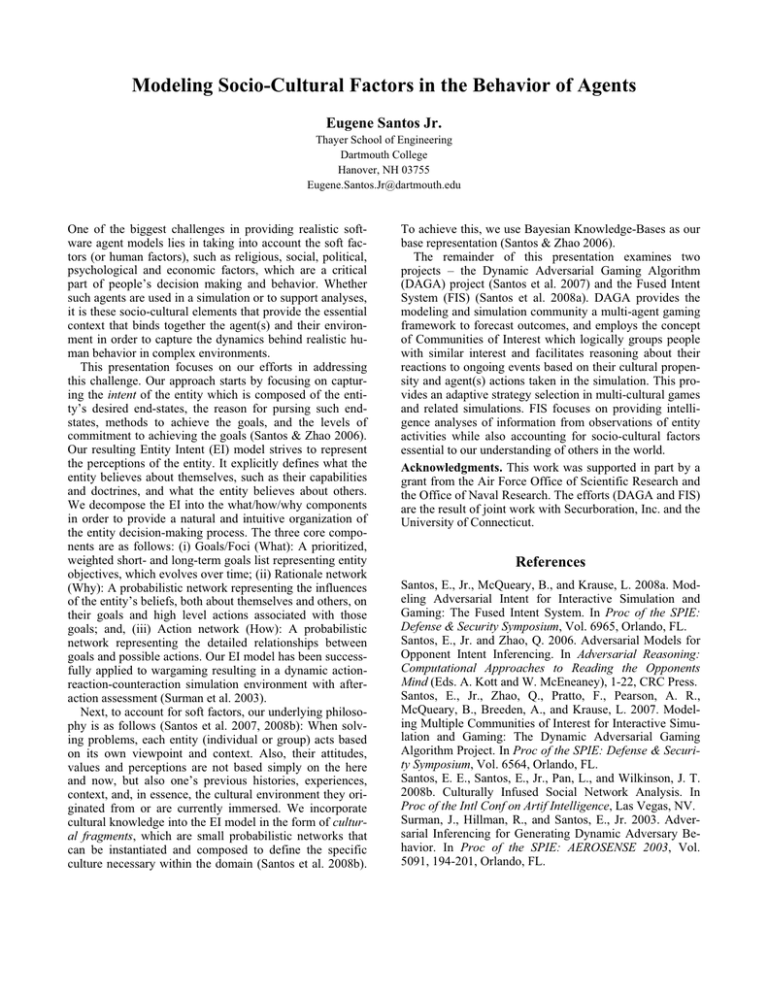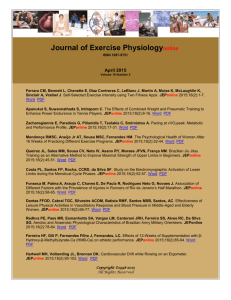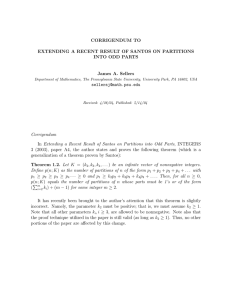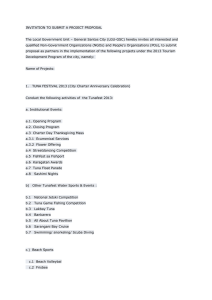Modeling Socio-Cultural Factors in the Behavior of Agents Eugene Santos Jr.
advertisement

Modeling Socio-Cultural Factors in the Behavior of Agents Eugene Santos Jr. Thayer School of Engineering Dartmouth College Hanover, NH 03755 Eugene.Santos.Jr@dartmouth.edu One of the biggest challenges in providing realistic software agent models lies in taking into account the soft factors (or human factors), such as religious, social, political, psychological and economic factors, which are a critical part of people’s decision making and behavior. Whether such agents are used in a simulation or to support analyses, it is these socio-cultural elements that provide the essential context that binds together the agent(s) and their environment in order to capture the dynamics behind realistic human behavior in complex environments. This presentation focuses on our efforts in addressing this challenge. Our approach starts by focusing on capturing the intent of the entity which is composed of the entity’s desired end-states, the reason for pursing such endstates, methods to achieve the goals, and the levels of commitment to achieving the goals (Santos & Zhao 2006). Our resulting Entity Intent (EI) model strives to represent the perceptions of the entity. It explicitly defines what the entity believes about themselves, such as their capabilities and doctrines, and what the entity believes about others. We decompose the EI into the what/how/why components in order to provide a natural and intuitive organization of the entity decision-making process. The three core components are as follows: (i) Goals/Foci (What): A prioritized, weighted short- and long-term goals list representing entity objectives, which evolves over time; (ii) Rationale network (Why): A probabilistic network representing the influences of the entity’s beliefs, both about themselves and others, on their goals and high level actions associated with those goals; and, (iii) Action network (How): A probabilistic network representing the detailed relationships between goals and possible actions. Our EI model has been successfully applied to wargaming resulting in a dynamic actionreaction-counteraction simulation environment with afteraction assessment (Surman et al. 2003). Next, to account for soft factors, our underlying philosophy is as follows (Santos et al. 2007, 2008b): When solving problems, each entity (individual or group) acts based on its own viewpoint and context. Also, their attitudes, values and perceptions are not based simply on the here and now, but also one’s previous histories, experiences, context, and, in essence, the cultural environment they originated from or are currently immersed. We incorporate cultural knowledge into the EI model in the form of cultural fragments, which are small probabilistic networks that can be instantiated and composed to define the specific culture necessary within the domain (Santos et al. 2008b). To achieve this, we use Bayesian Knowledge-Bases as our base representation (Santos & Zhao 2006). The remainder of this presentation examines two projects – the Dynamic Adversarial Gaming Algorithm (DAGA) project (Santos et al. 2007) and the Fused Intent System (FIS) (Santos et al. 2008a). DAGA provides the modeling and simulation community a multi-agent gaming framework to forecast outcomes, and employs the concept of Communities of Interest which logically groups people with similar interest and facilitates reasoning about their reactions to ongoing events based on their cultural propensity and agent(s) actions taken in the simulation. This provides an adaptive strategy selection in multi-cultural games and related simulations. FIS focuses on providing intelligence analyses of information from observations of entity activities while also accounting for socio-cultural factors essential to our understanding of others in the world. Acknowledgments. This work was supported in part by a grant from the Air Force Office of Scientific Research and the Office of Naval Research. The efforts (DAGA and FIS) are the result of joint work with Securboration, Inc. and the University of Connecticut. References Santos, E., Jr., McQueary, B., and Krause, L. 2008a. Modeling Adversarial Intent for Interactive Simulation and Gaming: The Fused Intent System. In Proc of the SPIE: Defense & Security Symposium, Vol. 6965, Orlando, FL. Santos, E., Jr. and Zhao, Q. 2006. Adversarial Models for Opponent Intent Inferencing. In Adversarial Reasoning: Computational Approaches to Reading the Opponents Mind (Eds. A. Kott and W. McEneaney), 1-22, CRC Press. Santos, E., Jr., Zhao, Q., Pratto, F., Pearson, A. R., McQueary, B., Breeden, A., and Krause, L. 2007. Modeling Multiple Communities of Interest for Interactive Simulation and Gaming: The Dynamic Adversarial Gaming Algorithm Project. In Proc of the SPIE: Defense & Security Symposium, Vol. 6564, Orlando, FL. Santos, E. E., Santos, E., Jr., Pan, L., and Wilkinson, J. T. 2008b. Culturally Infused Social Network Analysis. In Proc of the Intl Conf on Artif Intelligence, Las Vegas, NV. Surman, J., Hillman, R., and Santos, E., Jr. 2003. Adversarial Inferencing for Generating Dynamic Adversary Behavior. In Proc of the SPIE: AEROSENSE 2003, Vol. 5091, 194-201, Orlando, FL.





